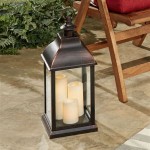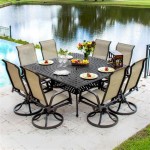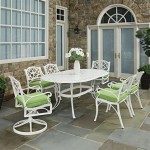Small Round Outdoor Chair Cushions: A Comprehensive Guide
Small round outdoor chair cushions are a common accessory for patios, balconies, and other outdoor seating areas. Their purpose is to enhance comfort and aesthetics for outdoor chairs, particularly those with round seats. Selecting the appropriate cushion involves careful consideration of several factors, including material durability, size, shape, and design, to ensure longevity and suitability for the specific outdoor environment.
The demand for these cushions stems from the desire to create inviting and comfortable outdoor spaces. They offer a practical solution for improving the seating experience, transforming hard or uncomfortable chairs into relaxing spots. Furthermore, the visual appeal of these cushions contributes significantly to the overall décor of the outdoor area, allowing individuals to personalize their spaces according to their preferences.
Understanding Material Properties for Outdoor Use
The selection of materials for small round outdoor chair cushions is crucial due to the constant exposure to weather elements. The impact of sunlight, rain, humidity, and fluctuating temperatures necessitates choosing materials that can withstand these conditions without significant degradation. The primary considerations for material selection include UV resistance, water resistance, mold and mildew resistance, and overall durability.
UV resistance is paramount as prolonged exposure to ultraviolet radiation from the sun can cause fading, cracking, and general weakening of the fabric. Materials like solution-dyed acrylics, such as Sunbrella, are known for their superior UV resistance. These fabrics are specifically designed to maintain their color and structural integrity even under intense sunlight. The dyeing process involves incorporating the color directly into the fiber during manufacturing, resulting in a more durable and fade-resistant finish compared to surface-dyed fabrics.
Water resistance is another critical factor, particularly in regions with frequent rainfall or high humidity. Materials that repel water prevent the cushion from becoming waterlogged, which can lead to discomfort and the growth of mold and mildew. Fabrics treated with water-repellent finishes, such as polyurethane coatings, are effective in preventing water penetration. These coatings create a barrier that causes water to bead up and roll off the surface of the fabric. It should be noted that water-repellent finishes may need to be reapplied periodically to maintain their effectiveness.
Mold and mildew resistance is essential for preventing the growth of microorganisms that thrive in damp environments. Mold and mildew can cause discoloration, unpleasant odors, and even structural damage to the cushion. Fabrics that are inherently resistant to mold and mildew, or those treated with antimicrobial agents, are preferred for outdoor use. These treatments inhibit the growth of microorganisms, ensuring that the cushion remains clean and hygienic. Closed-cell foams, used for the cushion filling, also contribute to mold and mildew resistance as they do not absorb water and provide a less favorable environment for microbial growth.
Durability encompasses the material's ability to withstand wear and tear from regular use. Fabrics with high abrasion resistance are less likely to tear or develop holes. The denier count, which measures the thickness of the individual fibers, is an indicator of durability. Higher denier fabrics are generally more resistant to abrasion and tearing. Additionally, the thread count, which refers to the number of horizontal and vertical threads per square inch, also contributes to the fabric's strength and durability.
Common materials used for small round outdoor chair cushions include olefin, polyester, and acrylic fabrics. Olefin is a synthetic fiber known for its strength, colorfastness, and resistance to staining. Polyester is another versatile option that offers good UV resistance and water resistance. Acrylic fabrics, particularly solution-dyed acrylics, are considered the premium choice due to their exceptional UV resistance, durability, and luxurious feel. The filling material options also vary, with polyester fiberfill and foam being the most common choices. Foam provides more support and retains its shape better than fiberfill, while fiberfill is generally more cost-effective and provides a softer feel. The selected filling should also be breathable to allow air circulation and prevent moisture buildup.
Determining the Correct Size and Shape
Ensuring that small round outdoor chair cushions fit properly on the intended chairs is crucial for both comfort and aesthetics. An ill-fitting cushion can be uncomfortable, unstable, and detract from the overall appearance of the seating area. Accurate measurements of the chair seat are essential to determine the appropriate cushion size. The diameter of the round seat should be measured at its widest point. It is also important to consider the depth or thickness of the cushion, as this affects the overall seating height and comfort.
The most common sizes for small round outdoor chair cushions range from 12 inches to 18 inches in diameter. However, custom sizes can be ordered to accommodate chairs with unusual dimensions. When selecting a cushion size, it is generally preferable to choose a cushion that is slightly smaller than the seat to allow for some leeway. A cushion that is too large may overhang the edges of the seat, creating an unstable and less aesthetically pleasing appearance.
The shape of the cushion should also match the shape of the chair seat. While round cushions are the most common, some chairs may have slightly oval or irregular shapes. In these cases, it may be necessary to opt for a custom-shaped cushion to achieve a perfect fit. The cushion should conform to the contours of the chair seat, providing even support and preventing gaps or overlaps.
Beyond the basic dimensions, the style of the cushion edge can also influence the overall fit and appearance. Cushions with knife edges have a clean, sharp look, while those with boxed edges have a more tailored and substantial appearance. Some cushions may also feature piping or welting around the edges, which adds visual interest and can help to define the shape of the cushion. The choice of edge style is largely a matter of personal preference, but it should be considered in relation to the overall design of the chair and the seating area.
Maintenance and Care for Longevity
Proper maintenance and care are essential for extending the lifespan of small round outdoor chair cushions and preserving their appearance. Regular cleaning, appropriate storage during inclement weather, and prompt attention to stains or spills can prevent long-term damage and ensure that the cushions remain comfortable and attractive for years to come.
Regular cleaning involves removing dirt, dust, and debris from the surface of the cushion. This can be done using a brush, vacuum cleaner, or damp cloth. For more thorough cleaning, the cushion covers can usually be removed and washed according to the manufacturer's instructions. It is important to use mild detergents and avoid harsh chemicals that can damage the fabric or cause fading. After washing, the covers should be air-dried or tumble-dried on a low setting to prevent shrinkage.
Promptly addressing stains and spills is crucial for preventing them from setting into the fabric. As soon as a spill occurs, it should be blotted up with a clean cloth or paper towel. Avoid rubbing the stain, as this can spread it further into the fabric. For more stubborn stains, a stain remover specifically designed for outdoor fabrics can be used. Always test the stain remover on an inconspicuous area of the cushion first to ensure that it does not cause discoloration or damage.
Proper storage during inclement weather is essential for protecting the cushions from the elements. When not in use, the cushions should be stored in a dry, protected area, such as a shed, garage, or covered patio. If storage space is limited, the cushions can be covered with waterproof covers to protect them from rain, snow, and sun. It is important to ensure that the cushions are completely dry before storing them, as moisture can lead to the growth of mold and mildew.
Beyond regular cleaning and storage, it is also important to inspect the cushions periodically for signs of wear and tear. Check for loose seams, tears, or fading. Minor repairs can often be made at home using a needle and thread. However, more significant damage may require professional repair or replacement. By addressing these issues promptly, it is possible to prevent them from escalating and prolong the life of the cushions.
Additionally, consider rotating the cushions periodically to ensure even wear. This helps to prevent certain areas from becoming excessively worn or faded compared to others. If the cushions have reversible sides, flipping them over can also extend their lifespan. Following these maintenance tips will contribute significantly to the longevity and appearance of small round outdoor chair cushions, ensuring that they continue to provide comfort and enhance the aesthetics of outdoor spaces.

Westin Outdoor Fadingfree Set Of 4 16 In Round Patio Circle Dining Chair Seat Cushions White Od3006 G Wh The Home

Swing Hanging Basket Seat Round Cushion Rattan Chair Pad Garden Indoor Outdoor Ebay

Small Round Outdoor Chair Cushions Discount

Kcavykas Outdoor Round Chair Cushions Cute Soft Warm Decorative Small Pillows Living Room Office Seat Cushion Pet Pillow For Kids Reading Dinning Couch Wal Mart Deals Walmart Business Supplies

Bistro Chair Cushion Sylvan Teal 16 Outdoor Round Barnett Home Decor

Small Round Outdoor Chair Cushions Discount

Round Patio Chair Cushions Home Furniture Design

Hsmqhjwe Indoor Outdoor Chair Cushions Round With Ties Pads For Dining Chairs Seat Cushion Bistro

Chair Cushions With Ties Round Seat Cushion Pad Pillows For In Assortment Rainbow Etsy

Outdoor Chair Seat Back Cushion Dining Garden Patio Soft Square Round Ebay








